At the foot of the Kamnik Alps, Slovenia’s capital is in a marshy region that has been inhabited for many thousands of years.
The world’s oldest wooden wheel has been brought to light here, dating back 5,200 years, and in Roman times this was a city of 6,000, commanded by a camp where there’s now a Medieval castle.
Modern Ljubljana is very compact, and most of the picks on our list are next to each other or within a couple of minutes on foot.
An earthquake in 1895 levelled much of the city, so in the early 20th century the Secessionist architect Jože Plečnik stepped in to update Ljubljana in his own inimitable style.
His contribution to Ljubljana’s cityscape could easily be compared to Gaudí in Barcelona, and is most spectacular on the Ljubljanica River, which was transformed by his embankments, bridges and waterside Central Market.
1. Old Town
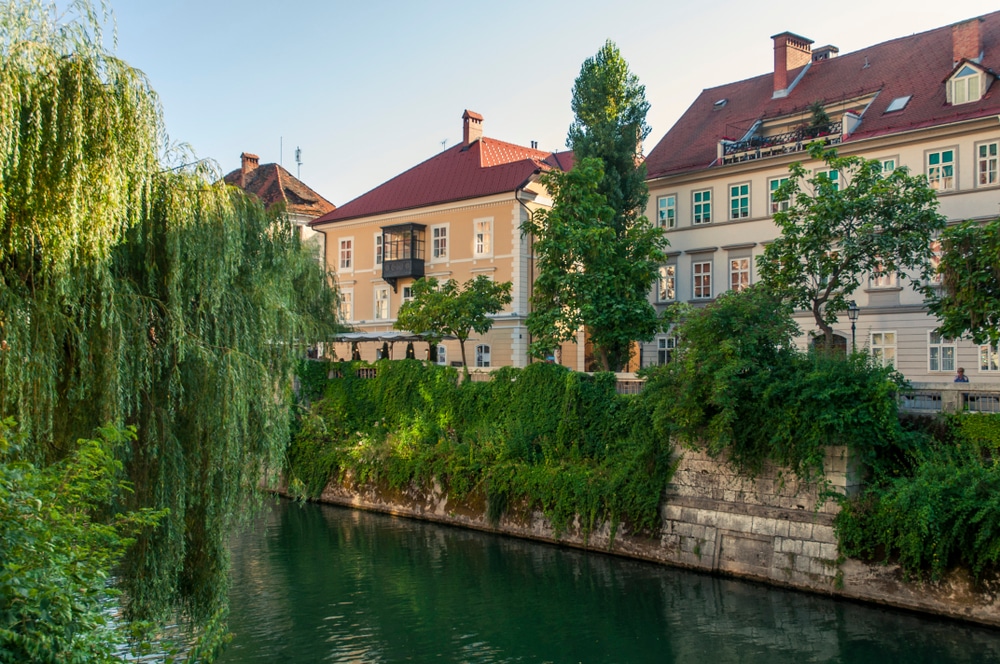 Source: Raphael Rivest / Shutterstock
Source: Raphael Rivest / ShutterstockThat earthquake in 1895 wasn’t the first disaster to hit Ljubljana, as an earlier tremor in 1511 destroyed the city.
Before then, fires had been a scourge for hundreds of years, and in 1524 wooden buildings were forbidden.
So while the Old Town still follows a Medieval street plan, the architecture is an alluring patchwork of Baroque townhouses and churches dating back to the 1600s interspersed with Secessionist/Art Nouveau buildings from the turn of the 20th century.
To discover the oldest corners of Ljubljana, make for Town Square (Mestni trg), merging with Old Square (Stari trg) in a ravine of genteel Baroque facades as it wraps around the base of Castle Hill.
This is all on the right bank of the Ljubljanica River, while the left bank was enclosed by the walls a little later, from the 14th century onwards.
There, just in from the Breg Embankment you’ll come to the New Square (Novi trg), which despite its name dates back to the 1200s.
A monument to behold here is the National and University Library of Slovenia, constructed between 1936 and 1941 and considered one of the high points of Jože Plečnik’s career.
2. Ljubljana Castle
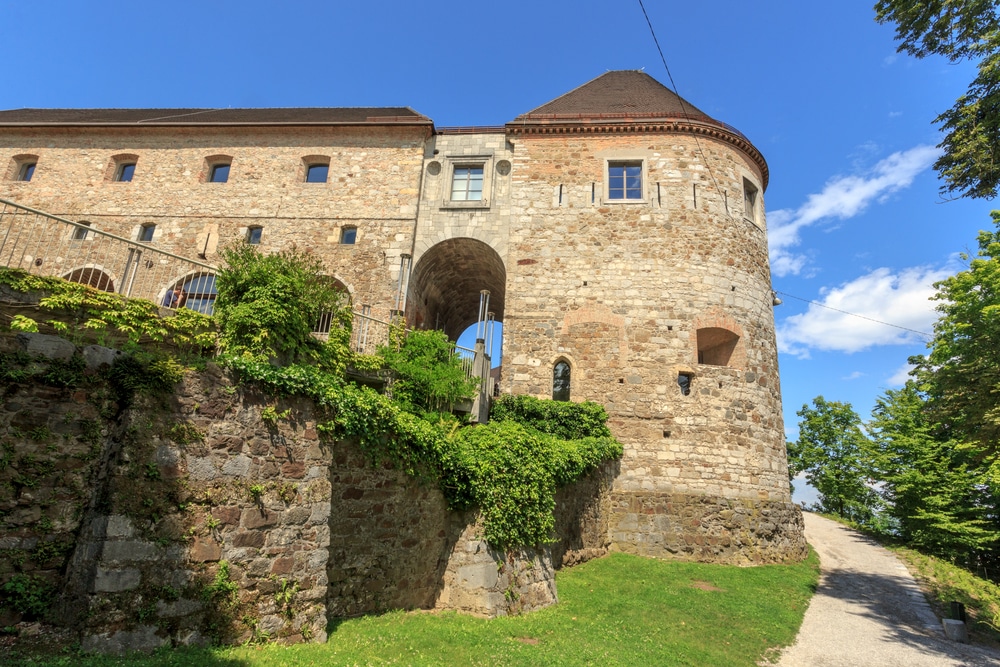 Source: Roka / Shutterstock
Source: Roka / ShutterstockThis great fortress has commanded the city from atop its wooded spur since the 11th century and appears on Ljubljana’s coat of arms.
Long before that time there was a Roman camp up here, following on from Illyrian and Celtic strongholds, in a continuous line dating back more than 3,000 years.
As we see it today, much of the castle is from a 15th-century reconstruction ordered by Frederick III, Holy Roman Emperor in the 15th century.
From that time onwards the stronghold was mainly a bulwark against attacks by the Ottomans, and after losing its status as a regional power, became a prison, barracks and arsenal.
One element harking back to Medieval times is the small St George’s Chapel, originally Gothic and redecorated in the Baroque style in the 18th century.
The views from the battlements are stunning, especially to the north where the Kamnik Alps loom in the distance. You can traverse the site with an audio guide, and the atmospheric courtyard is a stage for cultural events throughout the year.
And to make a visit a little more convenient you can catch the Castle Funicular zooming you up to the entrance from the foot of the hill in 60 seconds.
Website: https://www.ljubljanskigrad.si/en/
3. River Ljubljanica
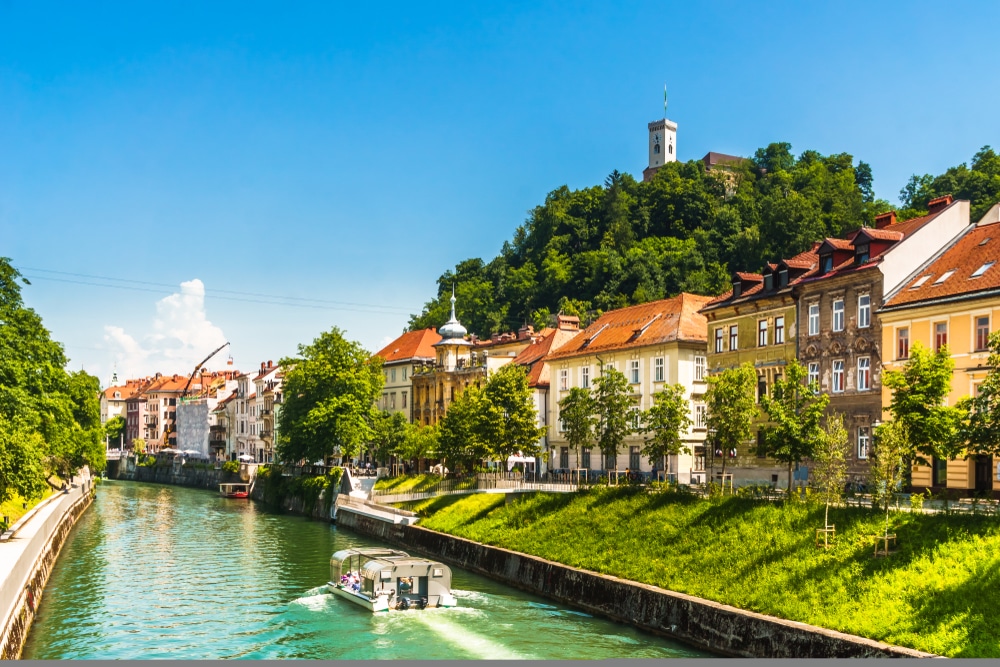 Source: streetflash / Shutterstock
Source: streetflash / ShutterstockThe simplest way to get to know Ljubljana is to take an easy walk along the river. On the way you’ll see many of the big landmarks on this list, as well as Jože Plečnik’s fine Central Market, his Triple Bridge, Cobblers’ Bridge and the embankments he designed in the 1930s and 40s.
And on the tree-lined left bank you’ll never be more than a few strides from the next cafe or bar terrace, with a view of the city that you’ll want to linger over.
The river has massive archaeological significance, having yielded thousands of artefacts offering tantalising glimpses of civilisations going back to prehistory.
Many of these are on show at the Ljubljana City Museum. Plečnik’s creations are all the more beautiful from the water, and cruise boats drift along the Ljubljanica in summer.
The Ljubljanica moves at a glacial pace and is perfectly safe if you fancy taking to the water for a standup paddleboard or kayak tour.
4. Triple Bridge
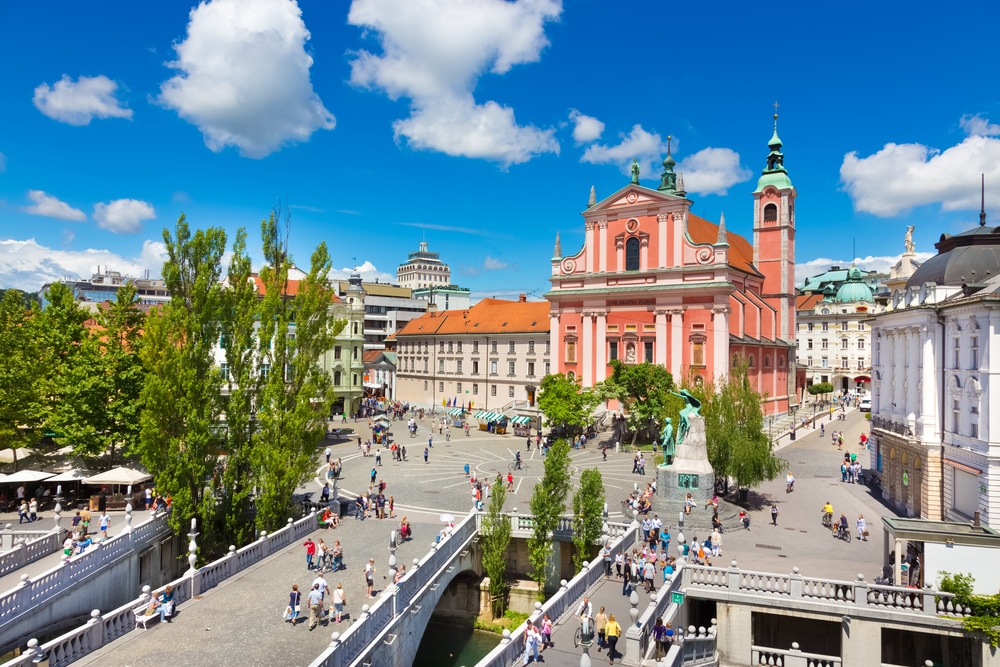 Source: Matej Kastelic / Shutterstock
Source: Matej Kastelic / ShutterstockA flourish of inspiration from Jože Plečnik turned a fine 19th-century crossing on the Ljubljanica into a famous monument for the city, known well beyond Slovenia’s borders.
There has been a crossing at this point in front of Prešeren Square since at least as long ago as the 13th century.
This was reconstructed several times down the centuries until the present Lower Bridge was unveiled in 1842, to a design by Italian architect Giovanni Picco.
Then from 1929, to alleviate congestion in the city centre, Plečnik added two extra spans. These radiate from a point on the right bank, crossing the river at an angle to the original bridge in the centre, and have double stairways on the outer sides leading down to the riverbank.
The result is a unique and endlessly photo-worthy mass of balustrades, made up of a total of 624 balusters. The Triple Bridge is all the more charming against the backdrop of Plečnik’s Central Market and the theatrical architecture of Prešeren Square.
5. Dragon Bridge
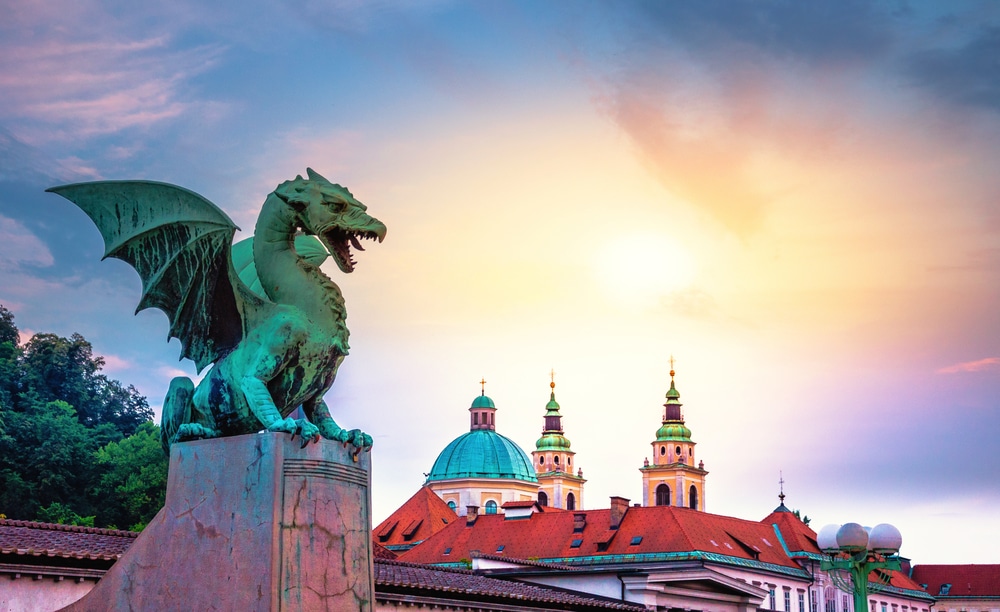 Source: Georgios Tsichlis / Shutterstock
Source: Georgios Tsichlis / ShutterstockOpened in 1901 as a response to the 1895 earthquake, this iconic bridge was built from reinforced concrete, making it one of the first bridges in Europe composed of this material.
The four dragons, on pedestals at each corner of the roadway, are a treasured part of the Ljubljana cityscape, rendered in sheet-copper and designed by Dalmatian architect Jurij Zaninović.
He trained under Otto Wagner, one of the leaders of the Vienna Secession, and who also mentored Jože Plečnik, who went on to transform much of Ljubljana.
The dragons are remarkably lifelike, and are accompanied by 16 little carvings of griffins at the base of the graceful Art Nouveau lamps along the balustrades.
Dragons have been a symbol for Ljubljana since Medieval times, a tradition most likely stemming from the legend of Saint George and the Dragon.
6. Central Market
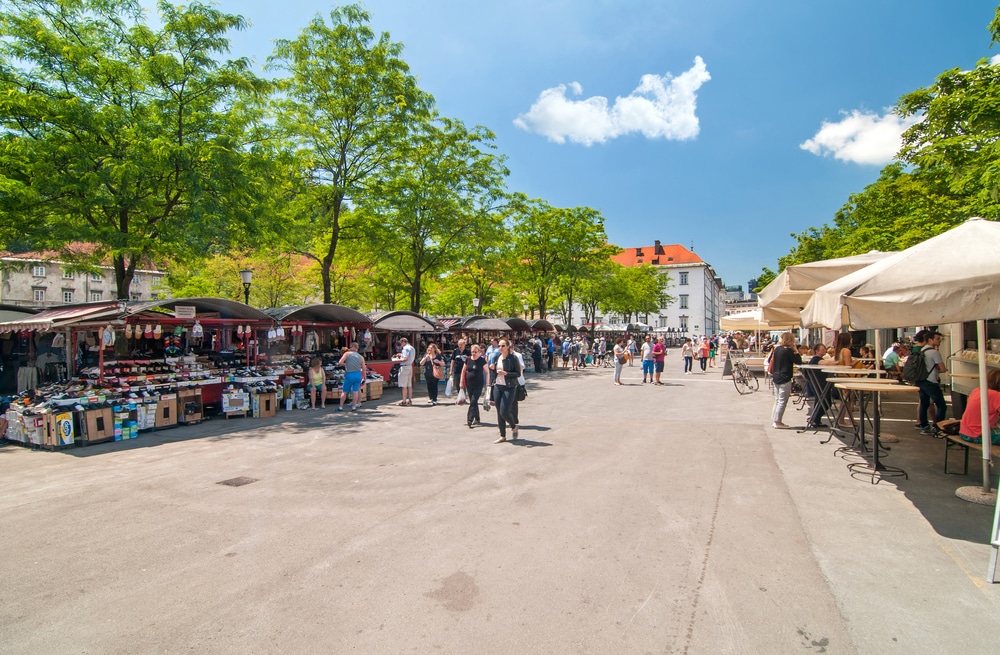 Source: Soru Epotok / Shutterstock
Source: Soru Epotok / ShutterstockWith outdoor and covered areas, Ljubljana’s Central Market spreads along the right bank of the Ljubljanica, between the Triple Bridge and Dragon Bridge.
The market trades every day except Sunday, and spills onto Vodnik Square and Pogačar Square.
Now, as well as a place to shop and get a taste for daily life in Ljubljana, the Central Market has real sightseeing value for the elegant, neo-Renaissance covered portion along the riverfront.
Like much of the heart of Ljubljana, this was designed by Jože Plečnik, and was put up between 1940 and 1944.
There’s a colonnade on the street side and two tiers of round-arched windows facing the river. The fishmongers’ stalls can be found on the lower level, while on both storeys you can potter around stalls for meat, dairy and baked goods, as well as herbs, spices and arts and crafts closer to the Triple Bridge at the west end.
As well as produce, it’s all an exciting destination for street food, especially on Fridays in spring and summer when there’s a globe-trotting variety of stalls on Pogačar Square for the “Open Kitchen” event.
7. Prešeren Square
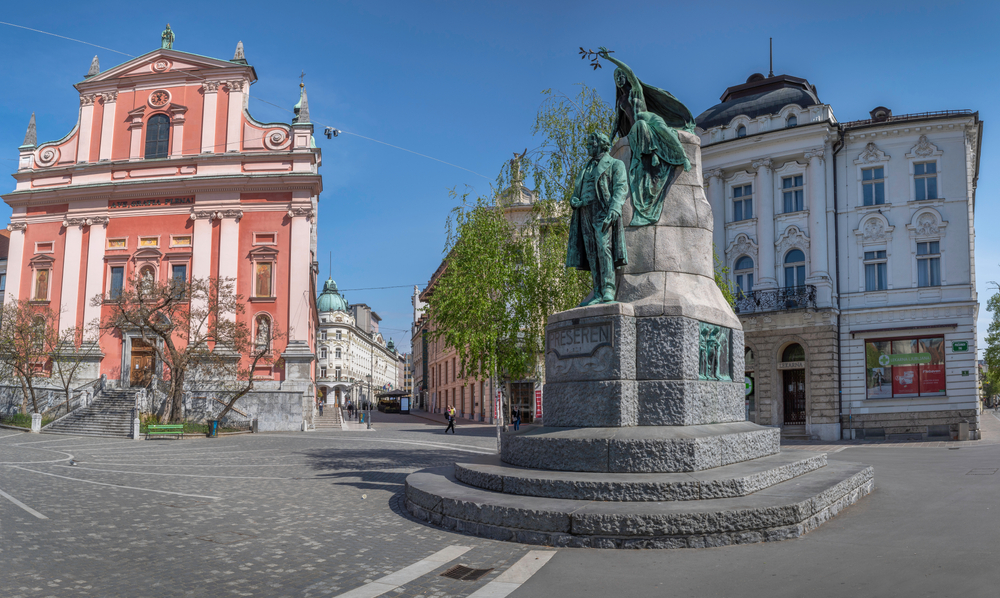 Source: Cortyn / Shutterstock
Source: Cortyn / ShutterstockLjubljana’s stirring central square is right beside the Triple Bridge where a series of streets meet on the left bank of the Ljubljanica.
The plaza is dedicated to the Romantic poet France Prešeren (1800-1849), who wrote in the Slovene language and whose impact on Slovene national identity is immeasurable.
The Prešeren Monument, accompanied by a muse, will greet you as soon as you cross the Triple Bridge and was inaugurated in 1905.
Close by is the pink facade of the Franciscan Church of the Annunciation, which we’ll cover a little later, while the square’s handsome bourgeois townhouses cropped up in the wake of the 1895 Ljubljana Earthquake.
Given its position at the confluence of several streets, Prešeren Square has always been a meeting point in the Old Town, and is also a gathering space for concerts, protests, sports events and the Ljubljana Carnival in February/March.
8. Robba Fountain
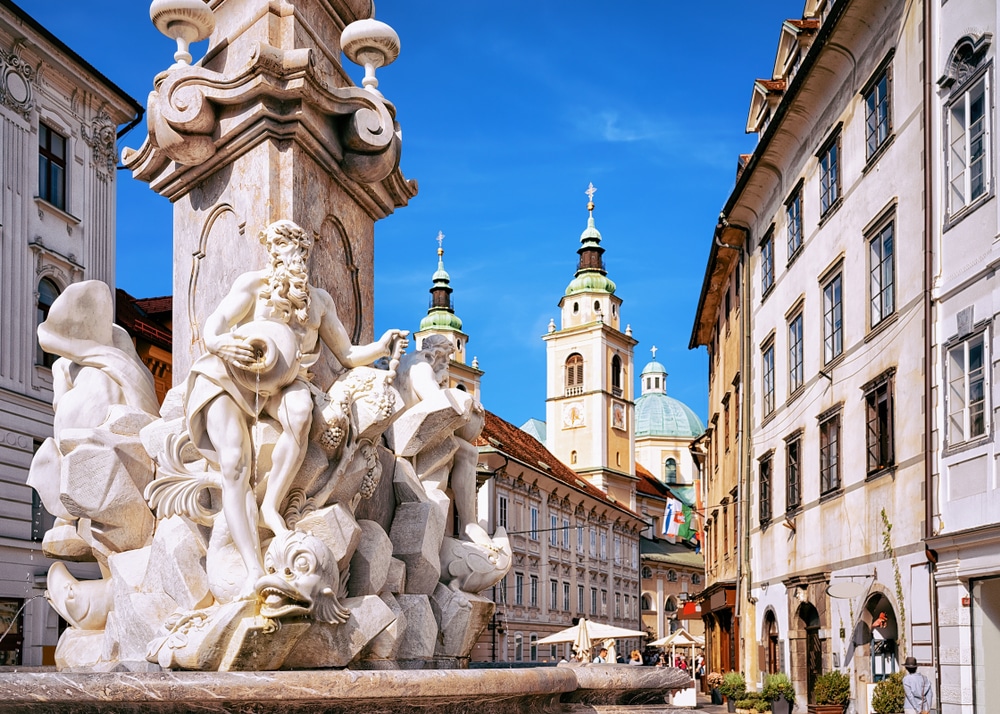
A symbol for Ljubljana, this fountain on Town Square was carved by the Italian Baroque sculptor Francesco Robba (1698-1757) and unveiled in 1751.
The monument takes inspiration from Rome’s Fontana dei Quattro Fiumi at Piazza Navona, but the shell-like basin and crowning obelisk are modelled on the Fontana della Pantheon (1575), by Giacomo della Porta.
Like the Fontana dei Quattro Fiumi, the Carrara marble figures of men holding jugs at the base of the obelisk represent the Carniolan rivers, in this case the Ljubljanica, Sava and Krka.
They also stand for the traditional regions, Upper, Lower and Inner Carniola. You’ll notice the different tones of each element, and the obelisk is marble quarried at Lesno Brdo in Vrhnika, while the basin is limestone from Podpeč.
The Robba Fountain in place today is a copy, while the original remains in great condition and can be seen at the National Gallery.
9. Cathedral of St Nicholas
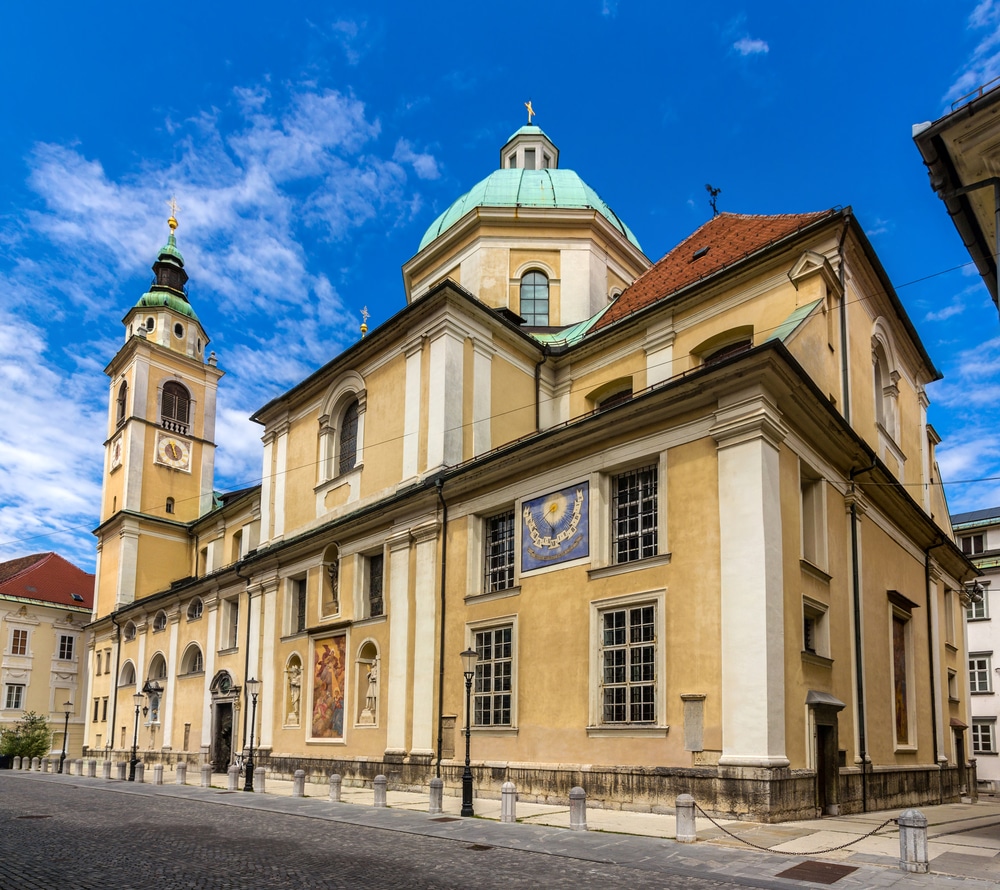 Source: Leonid Andronov / Shutterstock
Source: Leonid Andronov / ShutterstockThe green octagonal dome of Ljubljana’s Baroque cathedral soars over the Old Town and is a lasting emblem for the city.
What you see at the Cathedral of St Nicholas is the most recent version of a monument going all the way back to Romanesque church in the 13th century.
After a fire in 1362 this was replaced by a Gothic building, and that was levelled by yet another fire in 1469, thought to have been started during a Turkish raid.
The current Cathedral of St Nicholas is from the beginning of the 18th century and got its characteristic dome in 1841.
While the outside is a little understated, the interior brims with gilding and fabulous 18th-century art.
Most of the frescoes are the work of Giulio Quaglio from the 1700s and 1720s, while much of the sculpture, including the four Bishops at the base of the dome and the cherubim on the side altars, was produced in the first half of the 18th century.
Francesco Robba was responsible for the Carrara cherubim on the altar of the Holy Body of the Saviour, on the right hand side of the nave. Another celebrated artist, Matevž Langus (1722-1855) painted the frescoes on the dome in the years following its construction.
10. Tivoli Park
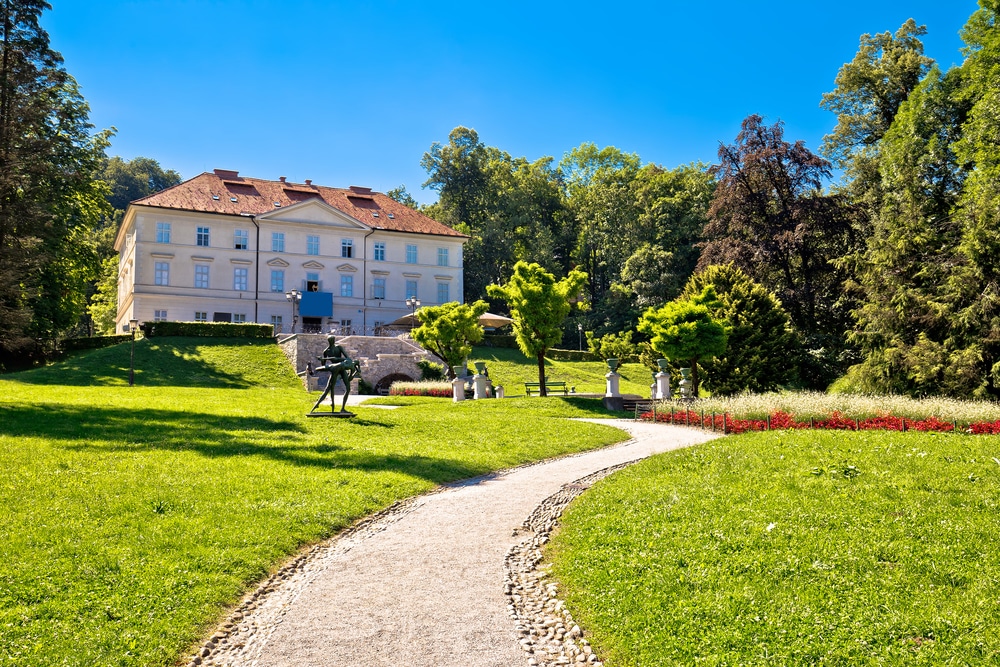 Source: xbrchx / Shutterstock
Source: xbrchx / ShutterstockLjubljana’s largest and prettiest park was first landscaped in the 1810s according to plans by the engineer Jean Blanchard when the city was in French hands. Tivoli Park was created by combining two formerly separate private estates.
The mansion for one of these, Podturn Manor, became Tivoli Castle. This regal Neoclassical residence is at the base of Rožnik Hill, and dates to the 17th century, with a 19th-century Neoclassical facade from the time of Habsburg field marshal Joseph Radetzky von Radetz.
Tivoli Castle is the western limit for the Jakopič Promenade, a stately avenue conceived by Jože Plečnik.
This broad artery runs straight through the park and puts Tivoli Castle on a grand axis, shooting along Cankar ulica and Čop ulica, right though to Prešeren Square, across the Triple Bridge, and concluding at Ljubljana Castle.
The promenade doubles as an outdoor gallery, flanked by exhibitions of large-format photography.
If you diverge from the main route you can explore the park with its formal flower beds, sculpted monuments, specimen trees and flowing lawns beckoning you up the slope of Rožnik Hill.
11. Metelkova Art Center
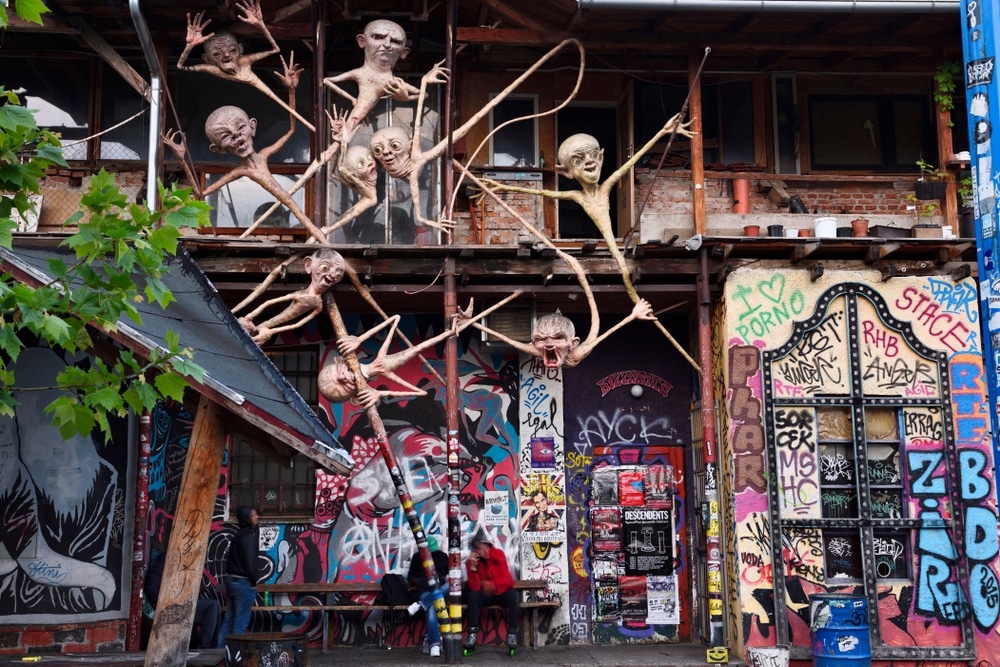 Source: Reimar / Shutterstock
Source: Reimar / ShutterstockSince the early-1990s this sprawling military site close to the centre of Ljubljana has been squatted by artists, activists and students, becoming a hub for alternative culture.
The barracks were built in the late-19th century for the Austro-Hungarian Army, and the story of the Metelkova City Autonomous Cultural Centre echoes that of Christiana in Copenhagen, not least in the informal cityscape that has developed here over the last three decades.
Metelkova stands for tolerance and creativity, as the location for art studios and several NGOs and associations for LGBT and feminist causes.
The center puts on exciting art exhibitions, concerts for all genres and a wealth of other performances and activities.
And although it’s still legally a squat, the complex is connected to the water system and power grid, paying for these utilities with the proceeds from its bars, exhibitions and gigs.
Website: http://www.metelkovamesto.org/?lang=txt_eng&
12. National Museum of Slovenia
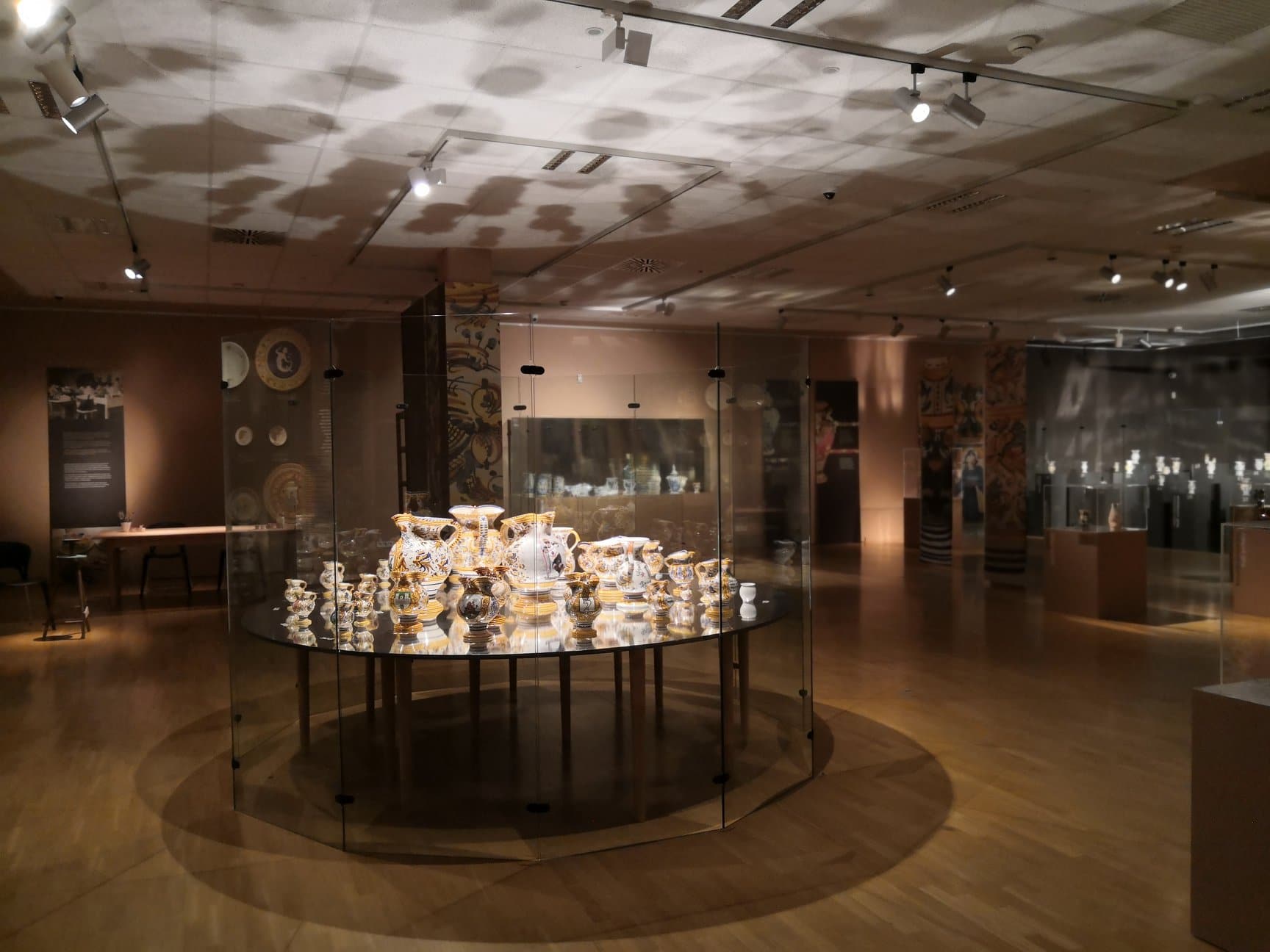 Source: facebook.com
Source: facebook.comYou can immerse yourself in Slovenian history up to the end of the Medieval period at this museum in an exquisite neo-Renaissance palace, purpose built in 1885.
The galleries cover prehistory, the Iron Age, Roman and Medieval times. One object that inspires fascination is the Divje Babe Flute.
It’s a cave bear femur, dating back around 43,100 years and pierced with precisely spaced holes, suggesting that this is the world’s oldest musical instrument.
The museum has a thrilling Roman lapidarium filled with some 200 pieces, including mosaic fragments, statues, building stonework and stelae from ancient Emona.
Added to this is a collection of Ancient Egyptian artefacts, as well as Medieval pottery, metal tools, jewellery and weapons.
Website: https://www.nms.si/en/
13. Franciscan Church of the Annunciation
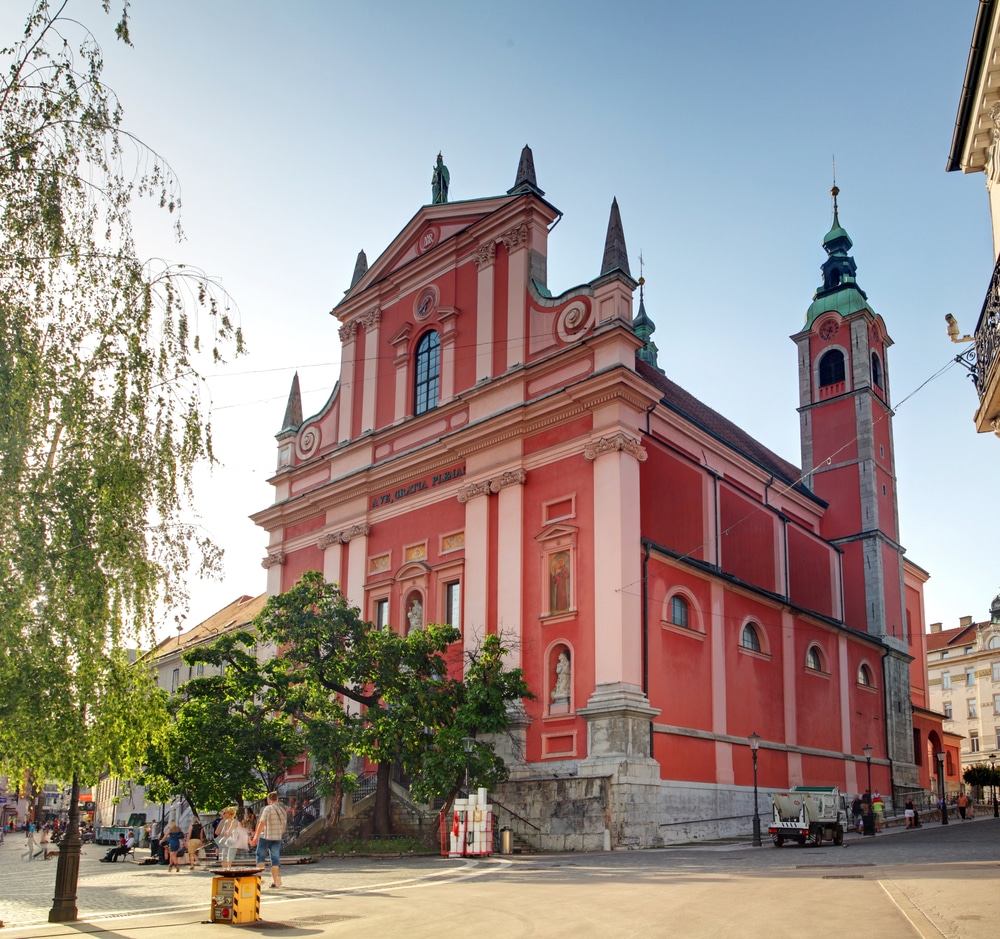 Source: TTstudio / Shutterstock
Source: TTstudio / ShutterstockSetting the scene on Prešeren Square is this early-Baroque church that went up between 1646 and 1660.
A few alterations have been made over the last 350+ years: The pink pastel facade, with its obelisk pinnacles, niches and Ionic (below) and Corinthian (above) pilasters, is 19th-century, while the bell towers were erected in 1719.
Topping the pediment is a copper image of the Madonna, the largest to be found in the city.
Go in, and there’s a single nave, with frescoes in the barrel-vaulted ceiling by Impressionist Matej Sternen, painted in the 1930s after the originals were cracked in the 1895 Ljubljana Earthquake.
The Baroque main altar was carved in the 1730s by Francesco Robba, the Italian sculptor who later became an honorary citizen of Ljubljana.
14. National Gallery of Slovenia
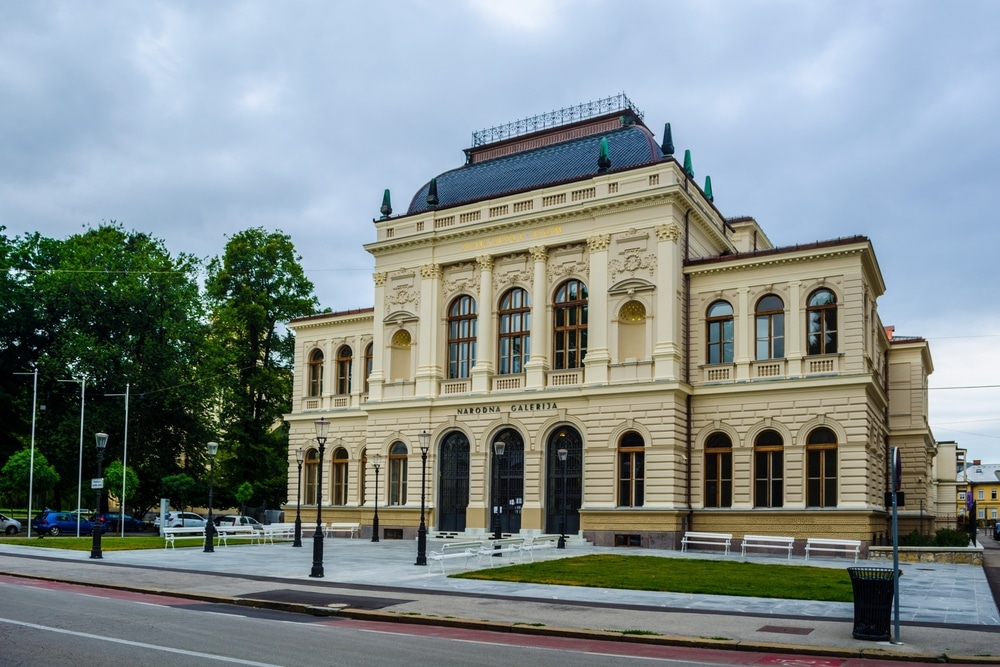 Source: trabantos / Shutterstock
Source: trabantos / ShutterstockIn a palatial Beaux-Arts building from 1896, the National Gallery of Slovenia is a gateway to the world of Slovene art, and has a collection reaching back to the High Middle Ages.
One artist who features prominently is Zoran Mušič (1909-2005), the first Modernist Slovenian painter to gain recognition in the west.
The National Gallery boasts the world’s only retrospective of his works, and you can get acquainted with other noted Slovene artists from the 19th and 20th centuries, like the Realist Ivana Kobilca (1861-1926), Impressionist Ivan Grohar (1867-1911) and the sculptor Ivan Zajec (1869-1952).
The museum puts on plenty of smartly-curated temporary exhibitions, with interesting selections from these holdings and world-class travelling shows. This is also where you can view the original Robba Fountain in all its Baroque glory.
Website: https://www.ng-slo.si/en/
15. Plečnik House
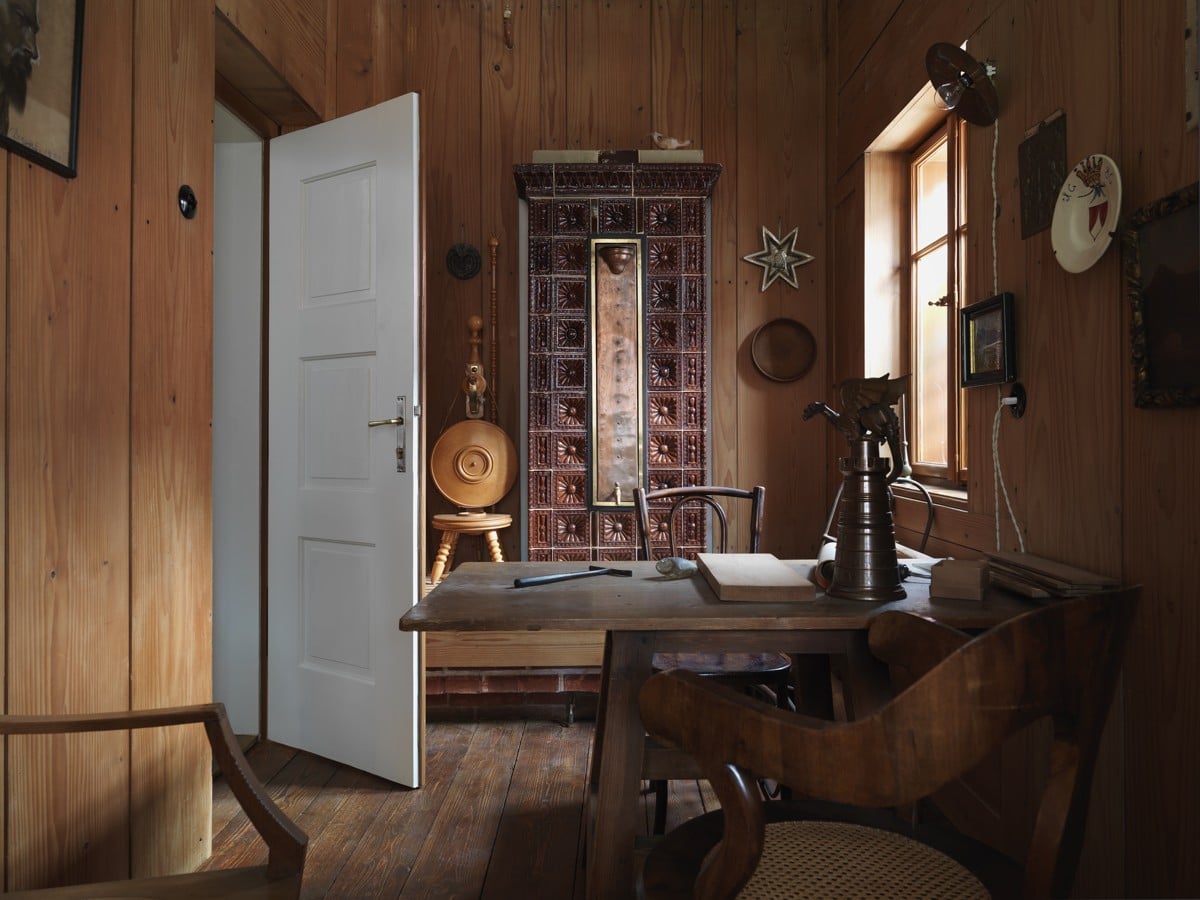 Source: visitljubljana.com
Source: visitljubljana.comJože Plečnik, the architect behind so much of modern Ljubljana, is a name that will keep coming up on your way around the city.
If you want to know more about the architect who left a lasting impression on Ljubljana you can visit his home.
Plečnik moved here in 1921 and in that first decade the House was given a cylindrical annexe and a neighbouring house was added to the property.
The decor and furnishings have been kept as they were when Plečnik resided here, complemented by the architect’s library, drawing tools and other personal items.
There’s an enthralling exhibition, presenting sketches, models, plans and photographs of the architect’s projects in Ljubljana.
For a glimpse of what might have been, you’ll also see plans for his unrealised Town Hall and grand monuments on Castle Hill and in Tivoli Park.
Website: https://mgml.si/en/plecnik-house/
16. City Museum of Ljubljana
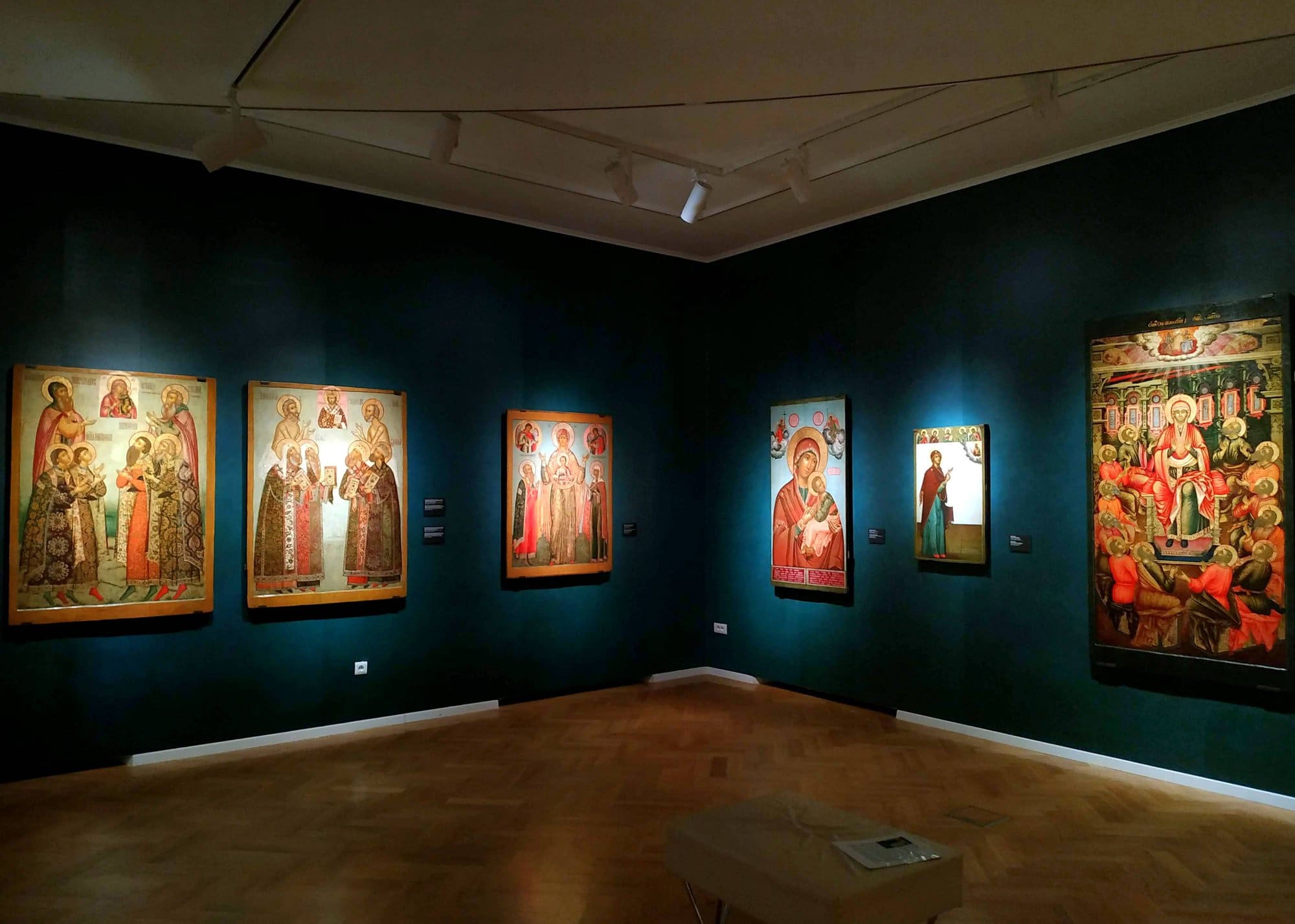 Source: facebook.com
Source: facebook.comThis museum documenting Ljubljana’s storied past is in a delightful townhouse built in the 1650s by the Auerspergs, one of Carniola’s wealthiest families.
The property was sold off to the city in 1927 and has housed the City Museum for more than 80 years. These galleries showcase captivating objects going back to prehistory, drawing on a collection of more than 200,000 pieces.
The most important exhibit is the world’s oldest wooden wheel, made from ash with an oak axle, dating back 5,200 years and preserved in the marshes south of the capital.
The permanent exhibition is an enlightening chronology of Ljubljana beginning at the time when this was all marshland occasionally inhabited by Neanderthals.
You’ll find out about early stilt dwellings on the marshes, Roman Emona and how Medieval Leibach thrived at the confluence of several trade routes.
Then comes the emergence of the Slovenian language and national identity in the Baroque city, followed by the tumultuous events of the 20th century when Ljubljana bounced from state to state.
Website: https://mgml.si/en/city-museum/
17. Congress Square
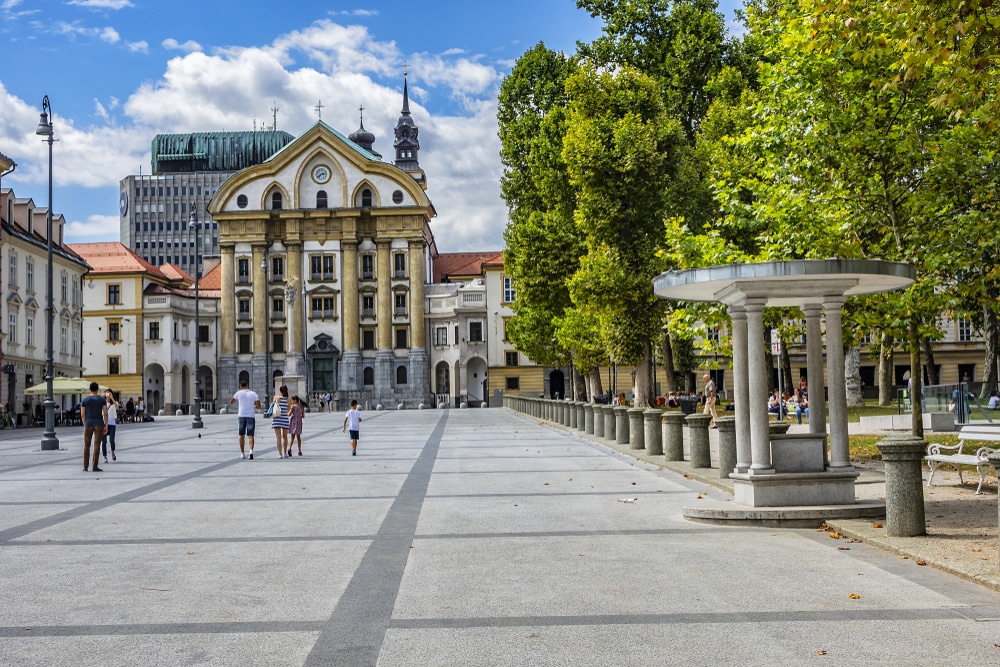 Source: Kiev.Victor / Shutterstock
Source: Kiev.Victor / ShutterstockThis grand plaza, just in from the bank of the Ljubljanica, has witnessed some of the defining events in Slovenian history.
Congress Square dates to 1821 and was laid out on the site of a Medieval Capuchin monastery that was dissolved under Habsburg Emperor Joseph II in the century before.
It was here in 1918 that Slovenia’s independence from Austria-Hungary was proclaimed, as it became part of the temporary State of Slovenes, Croats and Serbs.
In 1945, Josip Broz Tito gave a speech from the balcony of the University of Ljubljana building on the square’s south-east corner, and Slovene independence was publicly demanded on the square in a declaration read by poet Tone Pavček on May 8, 1989.
The design of the plaza dates to a renovation by Jože Plečnik in the late-1930s and the towering plane trees he planted are still here.
There’s grand and historic architecture all around, in the form of the Philharmonic Hall (1891), University of Ljubljana (previously the State Mansion from 1902-1918), Ursuline Church of the Holy Trinity (1726), Casino Building (1827) to name a handful.
Among the trees is a pretty Biedermeier bandstand from the 1830s, and on the east side is a replica of a golden monument discovered among the ruins of Roman Emona.
18. Nebotičnik
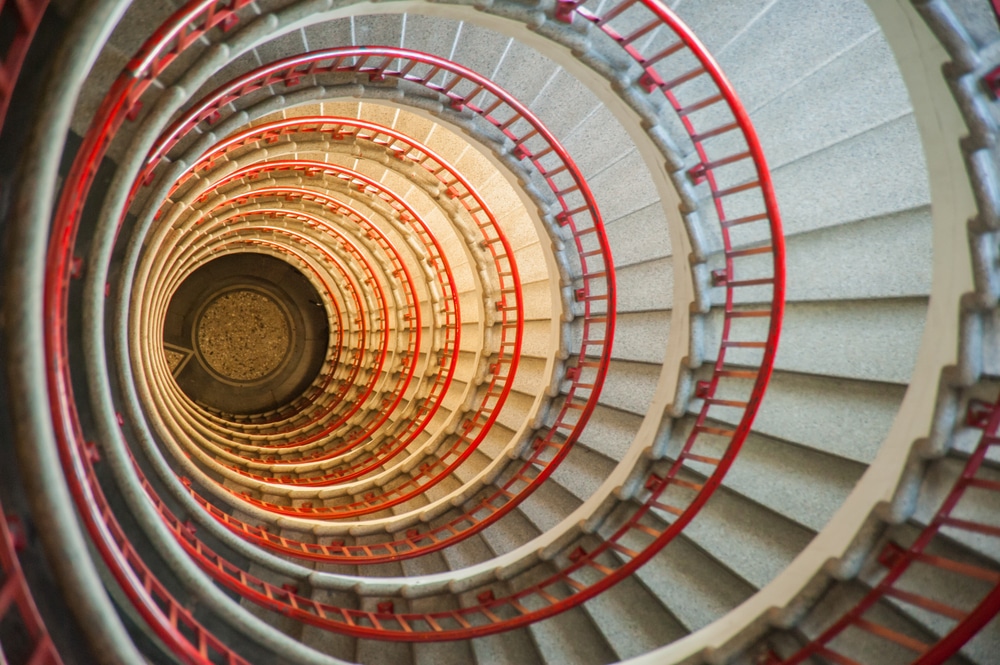 Source: Matic Stojs Lomovsek / Shutterstock
Source: Matic Stojs Lomovsek / Shutterstock“Skyscraper” in English, this Art Deco tower rising in the heart of Ljubljana was inspired by the American high-rises of the period, especially in its tripartite design.
When it was completed in 1933 Nebotičnik was the tallest building in the Balkans at 70.33 metres, but was also the tallest building in Europe to be purely residential.
Beyond its height, the tower was remarkable for rarely seen technology like air-conditioning, high-speed lifts and fuel oil central heating.
There’s an exquisite Art Deco stairway twirling up the centre of the building, or you can catch a lift to the upper floors which have a restaurant, club/lounge and a cafe with an observation terrace wrapping around the entire floor.
From here you can look west to Tivoli Park, north to the Kamnik Alps and east over Ljubljana’s historic centre.
Website: https://www.neboticnik.si/
19. Slovenian Railway Museum
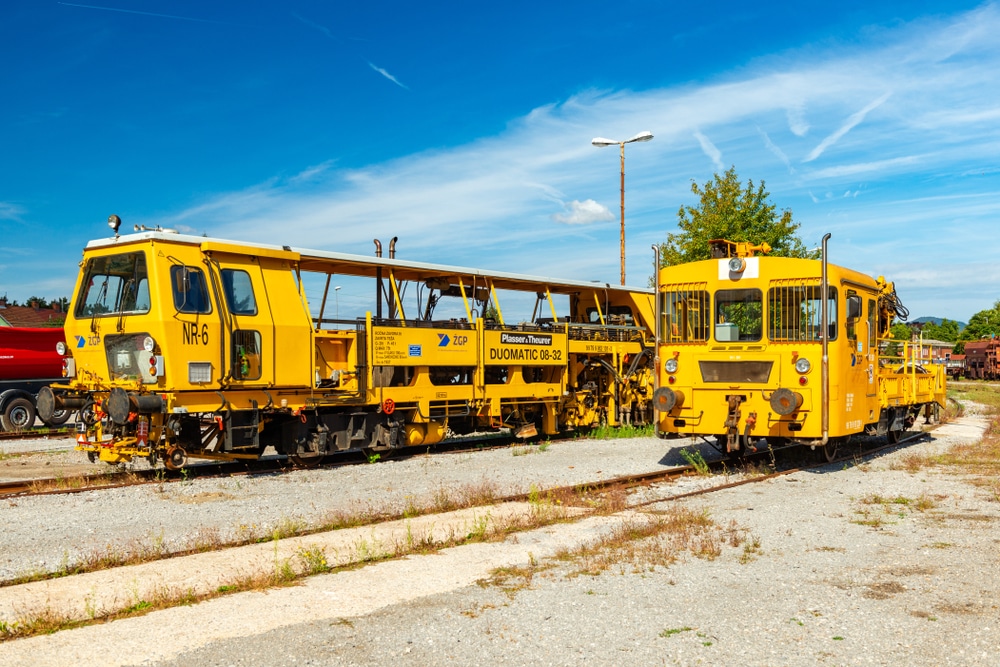 Source: Travellaggio / Shutterstock
Source: Travellaggio / ShutterstockRun by Slovenian Railways, this museum is at an atmospheric old depot near the defunct Ljubljana Šiška Station, north of Ljubljana’s historic centre.
This attraction is relatively small, but well laid-out, incorporating some intriguing old railway infrastructure at a shed (rotunda), turntable and stationmaster’s office.
There’s a beautiful fleet of steam locomotives to inspect in the main building, while you can also delve into other topics, like the science behind trains, or what was like to travel or work on Slovenia’s railways in the last years of the Austro-Hungarian Empire.
You can also trace the complex development of Slovenia’s railway system as it changed hands between various states through the 20th century.
And finally, you’ll be able to pore over a wealth of railway-related exhibits, from signalling and safety devices to uniforms, telegraphs, railway clocks, station PA systems, teleprinters, radios and antique railway lanterns.
Website: https://www.slo-zeleznice.si/en/sz-group/about-us/slovenian-railway-museum
20. Slovene Ethnographic Museum
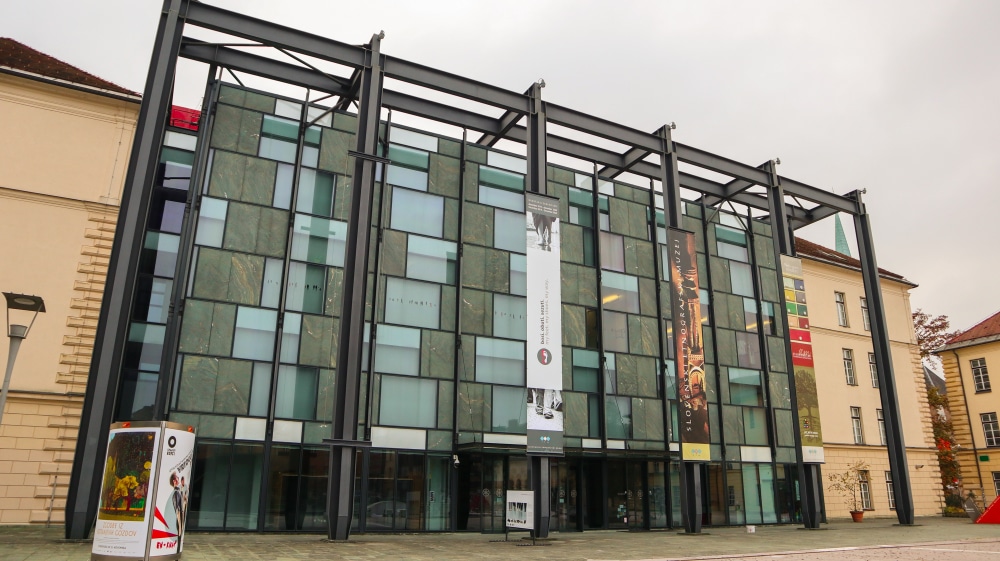 Source: Threestars Johnny / Shutterstock
Source: Threestars Johnny / ShutterstockTo get in touch with traditional Slovenian culture and livelihoods you could call in at this academically-oriented museum, which has collections that have been assembled since the 1820s.
The permanent exhibition, “Between Nature and Culture” introduces you to Slovene folk art, spiritual culture, festivals, costume and textiles, traditional dwellings, crafts and trades.
There are also collections for other European and non-European cultures, displayed in the exhibition, “I, We and Others”.
You can also view the preserved contents of a gingerbread and candle shop, rub by master craftsman Jakob Krbavčič on Ljubljana’s Trubarjeva ulica, accompanied by screens with footage of Jakob at work.
Website: https://www.etno-muzej.si/en
21. Ljubljana Town Hall
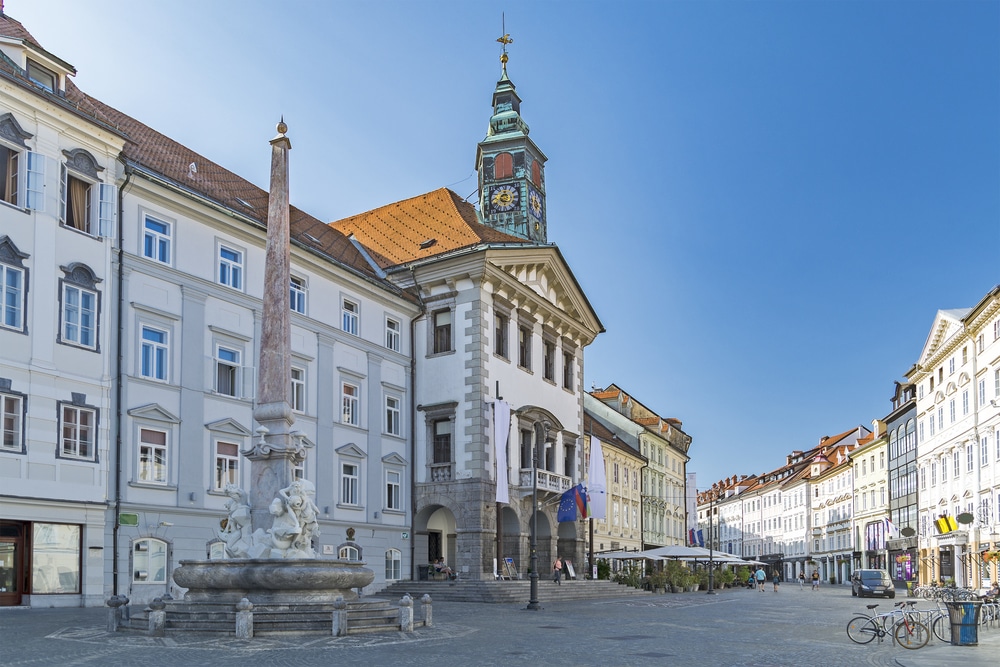 Source: Boerescu / Shutterstock
Source: Boerescu / ShutterstockA few metres from the Robba Fountain on Town Square stands Ljubljana’s Town Hall, which goes back to a Late Gothic building raised in 1484.
This monument has come through a lot of change down the years, and in the 1960s it was returned to the Venetian Baroque design first put in place in the late-1710s.
Under the arches in the porch you’ll see a couple of hints of what came before, in the form of a Late Gothic coat of arms and a 17th-century statue of Hercules and the Nemean lion, which used to be part of a fountain on Town Square.
The Town Hall’s various courtyards are used for exhibitions for local artists, to announce future city projects or show off finds from archaeological excavations.
The prettiest of these spaces is the Central Atrium, which has a baroque arcade and a fountain depicting Narcissus, also carved by Francesco Robba.
22. Ljubljana Zoo
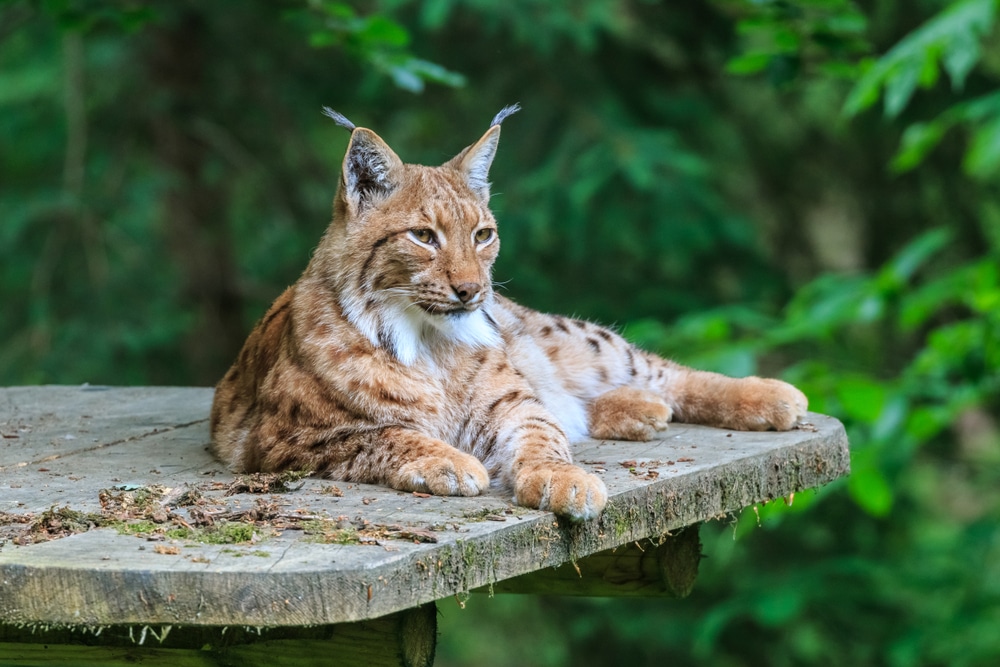 Source: Xseon / Shutterstock
Source: Xseon / ShutterstockSlovenia’s national zoo is embedded in forest and meadows on the southern slope of Rožnik Hill, an easy walk from the centre of Ljubljana.
The attraction moved to this location in 1949 and has recently come through a long-term renovation.
There are well over 100 different species at Ljubljana Zoo, but there’s a focus on animals from in and around Slovenia, where the Alpine, Pannonian and Mediterranean regions converge.
So as well as the likes of Siberian tigers, Asian elephants, cheetahs, ostriches, giraffes and zebras, you’ll get to see more local animals like brown bears, wolves, ibexes and various deer species.
As always, it’s a good idea to check the zoo’s daily schedule for feeding times and demonstrations, and if you’re visiting with younger members of the family, the Mini Zoo has goats, sheep and pigs that can be petted and hand-fed.
23. Castle Hill and Šance
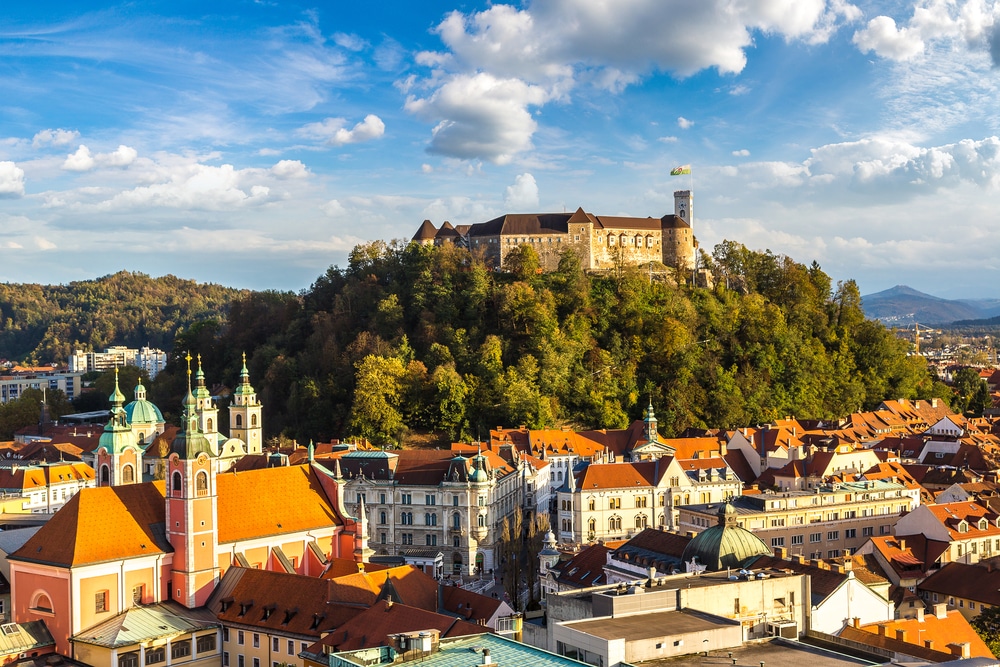 Source: S-F / Shutterstock
Source: S-F / ShutterstockLjubljana Castle can be the first stop on an extended outdoor excursion on the wooded slopes high above the city’s historical centre.
Tranquil, tree-flanked paths will guide to several breathtaking lookouts, where you’ll see Ljubljana backed to the north by the mighty Kamnik Alps.
For Ljubljana’s residents this is a destination for dog walks and jogging, and there are fitness stations up here too.
Be sure to make your way to Šance, a few hundred metres south-east of the castle. This winding, scenic promenade was plotted in the 1930s by Jože Plečnik and sits on the former ramparts of a historic fort once contained by the castle walls.
24. Town Square
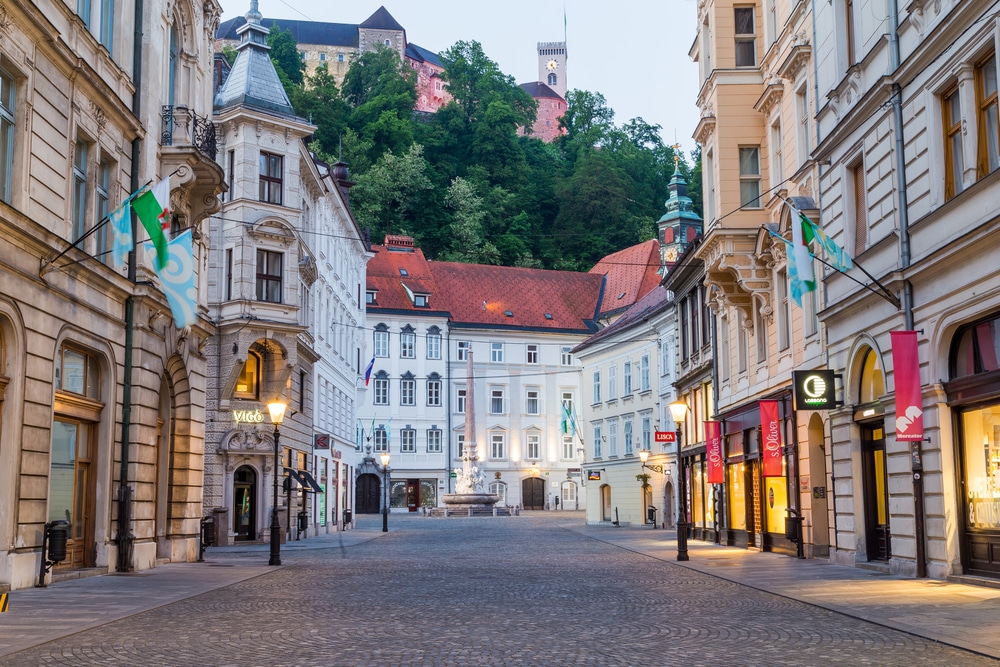 Source: mikecphoto / Shutterstock
Source: mikecphoto / ShutterstockSince as long ago as the 1100s this square, on an irregular crescent plan, has been a mainstay of life in Ljubljana.
Of course it’s the setting for the Town Hall and Robba Fountain, but as you can tell from the refined architecture fronting the square, many burgher families resided here.
Those townhouses continue to be named for previous occupants, like Lichtenbergova, Obrezova, Skobernetova and Krisper.
The latter, directly opposite the Town Hall, is the birthplace of Julija Primic (1816-1864), muse of the celebrated Slovene Romantic poet, France Prešeren (1800-1849).
Later, the composer Gustav Mahler lived in this building from 1881 to 1882 when he was conductor at the Carniolan Provincial Theatre.
There’s a line of benches on the west side where you can soak up the scene and look north to see the Cathedral of St Nicholas peeking over the rooftops. Many of the refined properties on Town Square ha
25. Butchers’ Bridge
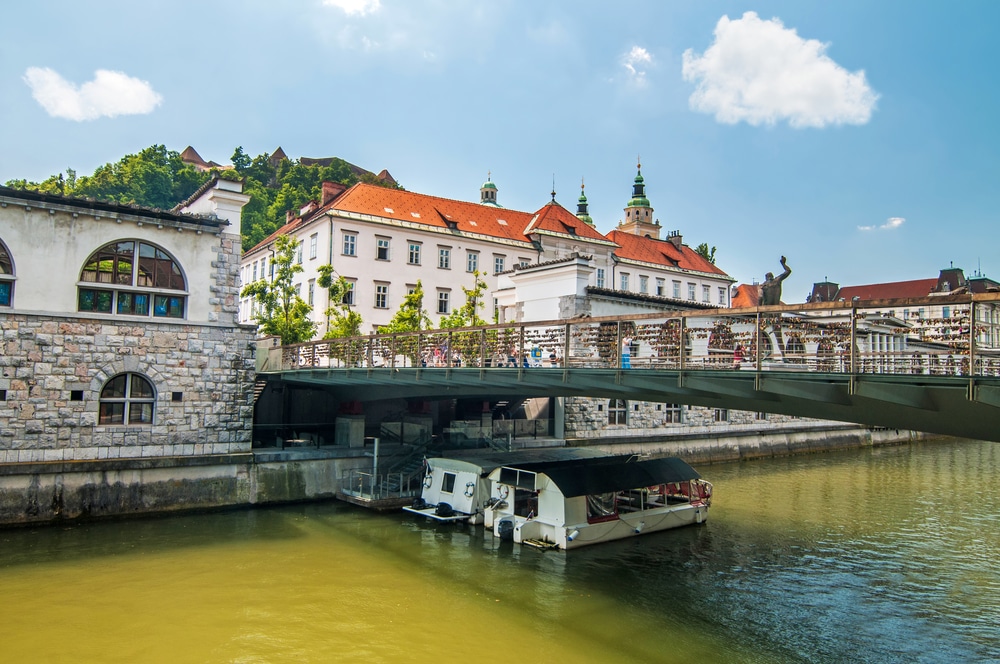 Source: Soru Epotok / Shutterstock
Source: Soru Epotok / ShutterstockWest of the Dragon Bridge, the Central Market and Petkovšek Embankment are linked by this footbridge conceived by Jože Plečnik in the 1930s but only constructed in the 2000s.
Butchers’ Bridge opened in 2010 and is a more discreet version of Plečnik’s design. The crossing is decorated with curious sculpture by Jakov Brdar, depicting figures from Judaeo-Christian and Ancient Greek mythology, like Prometheus, a satyr and Adam and Eve.
Not long after Butchers’ Bridge opened, it became a place for young couples to declare their love, attaching padlocks to the rows of cables below the handrails and throwing the key into the Ljubljanica.